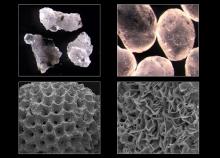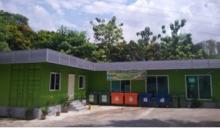Engineering & Technology Civil Engineering
News
14 Sep 2023
To address the lack of suitable training data for deep-learning semantic segmentation models in urban landscaping, researchers from Osaka University developed a method that generates a training dataset without the need for real images or a model of an existing city. The method, which is based on procedural modelling and image-to-image techniques, enables segmentation models to achieve comparable performance under some conditions at a fraction of the cost of real dataset generation.
06 Aug 2023
A team of researchers from Newcastle University of Singapore and National University of Singapore, led by Mr Loh Tick Boon, with academic supervisors Dr JJ Chong and Dr Kheng Lim Goh, has developed a novel and practical method of assessing the mechanical properties of structures, with potential application to structural health monitoring of large structures such as bridges and viaducts in Singapore.
28 Jul 2023
Newcastle University (UK) and the Energy Research Institute at Nanyang Technological University hosted a UK-Singapore symposium funded by the UK Government in April 2023. It aimed to foster partnerships and research for widespread electric vehicle adoption. The event featured discussions on technology, economics, and policy over three days, encouraging joint collaboration in advanced electric transport research and commercialization.
21 Nov 2022
Study can help to assess effectiveness of Minamata Convention on Mercury
15 Sep 2022
Researchers develop a new integrated framework that factors in the many variables relevant to accurate carbon emissions modeling in the transportation sector, allowing for policymakers to choose the best path to achieve carbon neutrality.
29 Jun 2022
Researchers analyze the collapse of the Misasa Railroad Bridge in Japan — an infrastructure failure caused by unprecedented flooding back in 2018 — to inform future flood-resistant designs.
18 Apr 2022
In disaster mitigation planning for future large earthquakes, seismic ground motion predictions are a crucial part of early warning systems. The way the ground moves depends on how the soil layers amplify the seismic waves (described in a mathematical site “amplification factor”). However, geophysical explorations to understand soil conditions are costly, limiting characterization of site amplification factors to date. Using data on microtremors in Japan, a neural network model can estimate site-specific responses to earthquakes based on subsurface soil conditions.
22 Feb 2022
Inspired by the woodpecker’s ability to strike trees with its beak rapidly and repeatedly without injury, engineers in Malaysia have used computer simulations to find ways to improve the design of composite beams used in impact-prone structures.
13 May 2021
Scientists reveal that the deterioration of modern concrete and asphalt structures is due to the presence of trace quantities of organic matter in these structures.
21 Feb 2019
Japanese researchers have investigated a collapsed bridge in Myanmar and surveyed the safety of seven similar bridges across the country.

10 Dec 2018
Do You Know How 3D Printing Will Disrupt the Future of Construction?
04 Dec 2017
A new soil classification, and tools to implement it, helps understanding of the properties of the ground underpinning geo-engineering projects.

28 Nov 2017
The Malaysian Concrete Canoe Competition (MCCC) 2017 was held on 25th and 26th November. The event aims at creating opportunity for civil engineering students to gain hands-on experience in innovative concrete mix designs. During the event, the longest concrete canoe was built and has been registered in the Malaysia Book of Record.
20 Nov 2017
Physicists are playing unexpected roles in meeting future global energy challenges by modeling technologies such as fracking.

03 Oct 2017
ASEAN’s Largest Green Technology Platform to Showcase Latest Green Innovations
28 Jun 2017
Electricity consumption in buildings will rise and increase GHG emissions. The biggest challenge for energy and carbon emissions reduction, is not only the relatively cheap price of electricity, but to refurbish existing buildings to become more energy efficient and lessen its environmental impact.
22 Jun 2017
Zero Waste Campaign (ZWC) is one of the university’s longest and most consistent endeavours. It is unique due to the bottom-up and top-down synergy that characterizes its development. It was set-up to spearhead the development of a more sustainable waste management model in the UM campus and ultimately achieve the status of a zero waste campus.

25 May 2017
Aid & Development Asia Summit, taking place on 14-15 June at the MICC2 in Nay Pyi Taw, Myanmar, will discuss on building a culture of resilience and strengthening disaster preparedness and roundtables on emergency communication, early warning systems, GIS, data collection and mapping.
Events
Sorry, nothing coming up for this discipline
Researchers
Norhafezah binti Kasmuri has obtained her Degree in Civil and Environmental Engineering from Universiti Kebangsaan Malaysia in 2001. She has received her Master of Science in Water Resources Engineering and Management (WAREM) from Universitat Stuttgart, Germany in 2004. She has completed her study of Doctor of Philosophy in Chemical Engineering from Swansea University, Wales, the United Kingdom in 2014. She has been serving UiTM since August 2014 as a senior lecturer at the School of Civil Engineering, College of Engineering, Universiti Teknologi MARA, Shah Alam.
Prof. Yang Yong's primary research interest is in the development and mechanical behavior of advanced structural materials, such as metallic glasses and high entropy alloys. His recent research also extends to mechanics of flexible electronics and hydrogels.
Dr. Fariha is a Senior Lecturer and a Civil Engineer at Universiti Teknologi MARA, Malaysia. She is actively conducting research on Kenaf-sorb beads that is potentially for wastewater treatment at the factory’s effluent point.
Professor in Department of Civil Engineering, The University of Tokyo, Institute of Industrial Science. Studies soil mechanics, cave-ins and sinkholes.
Associate Professor at Tohoku University's International Research Institute of Disaster Science (IRIDeS) researching disaster sciences.
Associate Professor, International Research Institute of Disaster Science, Tohoku University
Director of the International Research Institute of Disaster Science (IRIDeS) at Tohoku University since April 2014, and also is a professor of Tsunami Engineering
Giants in history
Sir Mokshagundam Srinivasa Shastry Vishveshwarayya (15 September 1860 – 14 April 1962) is widely regarded as India’s most outstanding engineer. In a career that spanned almost his entire life, Vishveshwarayya played a pivotal role in several engineering projects, including designing the Krishnarajasagara dam that is still the source of irrigation and drinking water for parts of Karnataka today.
Fazlur Rahman Khan (3 April 1929 – 27 March 1982) was a Bangladeshi-American structural engineer and architect who invented the tube principle, which formed the basis for modern skyscraper design.
























